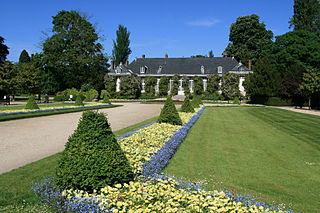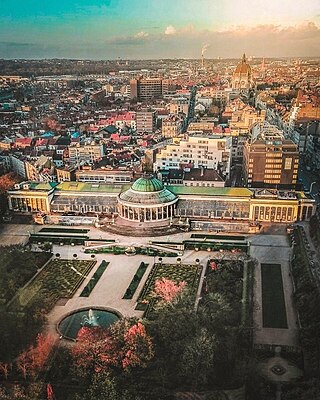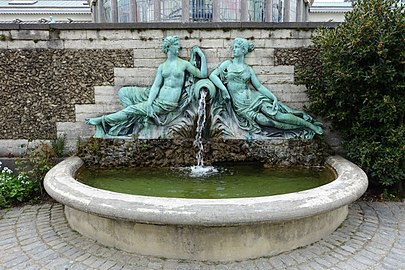
The Jardin des plantes, also known as the Jardin des plantes de Paris when distinguished from other jardins des plantes in other cities, is the main botanical garden in France. The term Jardin des plantes is the official name in the present day, but it is in fact an elliptical form of Jardin royal des plantes médicinales, which is related to the original purpose of the garden back in the 17th century.

The Meise Botanic Garden, until 2014 called the National Botanic Garden of Belgium, is a botanical garden located in the grounds of Bouchout Castle in Meise, Flemish Brabant, just north of Brussels. It is one of the world's largest botanical gardens, with an extensive collection of living plants and a herbarium of about 4 million specimens. The current garden was established in 1958 after moving from central Brussels; the former site is now the Botanical Garden of Brussels.

The Royal Greenhouses of Laeken are a vast complex of monumental heated greenhouses in the park of the Royal Palace of Laeken, Belgium. The historic complex contains tropical, subtropical and cold greenhouses, and is home to the famous Royal Botanic Collection, which includes large collections of camellias, orange trees and many plants originating from the African parts of the former Belgian Empire.

Alphonse Hubert François Balat was a Belgian architect.

Louis Benoît van Houtte was a Belgian horticulturist who was with the Jardin Botanique de Brussels between 1836 and 1838 and is best known for the journal Flore des Serres et des Jardins de l'Europe, produced with Charles Lemaire and M. Scheidweiler, an extensive work boasting more than 2,000 coloured plates in 23 volumes published between 1845 and 1883.

Botanique (French) or Kruidtuin (Dutch) is a Brussels Metro station on the northern segment of lines 2 and 6. It is located under the Small Ring at the Rue Royale/Koningsstraat in the municipality of the Saint-Josse-ten-Noode, north of the City of Brussels, Belgium. It opened as a premetro station on 18 August 1974 and became a full metro station on 2 October 1988.
Henri Guillaume Galeotti was a French-Belgian botanist and geologist of Italian parentage born in Paris. He specialized in the study of the family Cactaceae.

The jardin des plantes de Montpellier is a historic botanical garden and arboretum located on Boulevard Henri IV, Montpellier, Hérault, Occitania, France. It is maintained by the Université Montpellier 1 and open afternoons daily except Monday; admission is free.

The jardin des plantes d'Angers (4 hectares) is a municipal park and botanical garden located on Place Pierre Mendès France, Angers, Maine-et-Loire, Pays de la Loire, France. It is open daily without charge.
The Jardin botanique du Montet, sometimes also called the Jardin botanique de Nancy, is a major botanical garden operated by the Conservatoire et Jardins Botaniques de Nancy. It is located at 100, rue du Jardin Botanique, Villers-lès-Nancy, Meurthe-et-Moselle, Lorraine, France, and open daily; free entrance but an admission fee is charged to visit the greenhouses.

The jardin des plantes de Lille is a municipal botanical garden located on the rue du Jardin des plantes, Lille, Nord, Nord-Pas-de-Calais, France.

The Jardin des Plantes de Rouen is a municipal botanical garden located at 7, rue de Trianon, Rouen, Seine-Maritime, Upper Normandy, France. It is open daily without charge.
Alfred Wesmael was a Belgian professor of botany. His outstanding work in taxonomy saw him invited to become Visiting Professor at the University of Washington.

The Rue Royale or Koningsstraat is a street in Brussels, Belgium, running through the municipalities of Schaerbeek, Saint-Josse-ten-Noode and the City of Brussels. It is limited to the south by the Place Royale/Koningsplein in the city centre and to the north by the Place de la Reine/Koninginplein in Schaerbeek.

Le Botanique is a cultural complex and music venue in Saint-Josse-ten-Noode, Brussels, Belgium. The building was previously the main orangery of the National Botanic Garden of Belgium and even as part of the garden had hosted cultural events. In 1958, the National Botanic Garden moved to Meise, Flemish Brabant. Le Botanique opened in 1984, and the gardens in front are now the Botanical Garden of Brussels.

L'École Nationale Supérieure d'Horticulture was a French grande école of horticulture.

Neoclassical architecture appeared in Belgium during the period of Austrian occupation in the mid-18th century and enjoyed considerable longevity in the country, surviving through periods of French and Dutch occupation, and the birth of Independent Belgium, surviving well into the 20th century.

The Conservatory and Botanical Garden of the city of Geneva is a museum and an institution of the City of Geneva.

Plant Ecology and Evolution is a triannual peer-reviewed open access scientific journal covering ecology, phylogenetics, and systematics of plants, including related fields such as comparative and developmental morphology, conservation biology, evolution, phytogeography, reproductive biology, population genetics, and vegetation studies. Although the geographic scope is global, it particularly publishes about botany in (sub)tropical Africa.

Les Orangeries of Bierbais is located in Hévillers, a section of the municipality of Mont-Saint-Guibert, located in the Wallonia in the province of Walloon Brabant in Belgium.




























